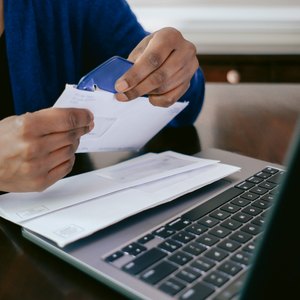
It may be easier than you think to generate a fake bank statement and other financial documents. Some companies sell "novelty" bank statements – supposedly for theatrical productions – which are fake documents that look like the real thing. Receiving a phony bank statement is alarming, as it indicates that your identity is under attack. You need to respond immediately and take steps to prevent future occurrences.
Watch for Red Flags
Your bank statement reports all account activity for the period, including balances, transactions and fees. An unusual appearance and inconsistent data are tip-offs that you may have received a phony statement. Here are some strategies to help you detect a fake bank statement:
- Check for visual changes. Look for changes in font type, color and layout. Check whether the bank logo has changed. See if the decimal points and other statement elements are misaligned or missing. If you receive a paper statement, check whether the envelope looks different. Electronic statements are PDF files and are vulnerable to hacking. In addition, be alert for statements arriving before your current banking cycle ends.
- Check the math. The opening balance of your current statement should match the ending balance of your previous statement. You should recognize all entries including account numbers, deposits, withdrawals, transfers, checks and fees. The totals should reconcile, whether you check them manually or use personal financial software.
- Check your name and address. Make sure your personal information is correct. An unsolicited change to your name or address may also indicate fraud.
Respond to Suspected Fraud
You should immediately contact your bank to verify whether a suspicious bank statement is legitimate. If it appears that you are the victim of financial fraud, you should change your bank sign-on password and PIN. Close your existing accounts and reopen them with new numbers; do this for your bank accounts, debit cards and credit cards. You will require new checks and deposit slips as well.
ChexSystems® lets you request a free copy of your report through them so you can obtain complete information about your checking accounts. If a fraudster has opened bogus bank accounts, close them by contacting each bank and reporting the problem.
If a scammer uses your stolen information to write phony checks under your name, have your bank stop payments on the account as you close it. Also, ask the bank to report bogus checks to its check verification system, which will instruct businesses to refuse the bad checks. Inform any businesses that accepted a bad check of the identity fraud to prevent the start of a collection action.
You can contact the check verification companies, such as TeleCheck and Certegy, to report any stolen or phony checks. Ask these companies to tell businesses to refuse the bad checks.
Visit the Federal Trade Commission's Identity Theft website. You can complete the FTC online form or call its phone number (1-877-438-4338) to report the details of the fraud. If you purchased ID theft insurance, call the company and make a full report. It should work with you to help reverse the effects of ID fraud.
Protect Your Identity
It's a good idea to check your bank documents as soon as they arrive. Never give out confidential information, such as passwords and PINs, and always use strong, unique passwords to access your bank's website. Request two-factor authentication on all your accounts, and set up creative answers to online security questions. In addition, set up security features such as automatic alerts to monitor bank and credit card account activity.
Don't use public Wi-Fi to connect online to your financial institutions. Never click on email links – you can contact the sender independently. Consider buying ID theft protection, but be sure you understand what you'll get for your money.
Consider installing ad blockers on your computer to prevent infected ads. See if your bank accepts biometric identification (i.e., fingerprints) for online access. Finally, help avoid scams by using security software on all your devices and updating it frequently.
References
Tips
- To help prevent future identity fraud, the Identity Theft Resources Center. Many banks recommend that you remove your driver’s license, Social Security number and full name from your checks and set up hard-to-guess passwords and PINs on your account. In addition, you should put a lock on your mailbox and mail checks in thick or security-printed envelopes.
Warnings
- Always contact your bank immediately if you believe you’ve been the victim of checking account fraud or identity theft as waiting too long to report a crime can result in your financial institution holding you liable for unauthorized transactions. In addition, check out the Federal Trade Commission’s Resolving Specific Identity Theft Problems online resource to determine other actions you should take for your specific issue.
Writer Bio
Eric Bank is a senior business, finance and real estate writer, freelancing since 2002. He has written thousands of articles about business, finance, insurance, real estate, investing, annuities, taxes, credit repair, accounting and student loans. Eric writes articles, blogs and SEO-friendly website content for dozens of clients worldwide, including get.com, badcredit.org and valuepenguin.com. Eric holds two Master's Degrees -- in Business Administration and in Finance. His website is ericbank.com.

